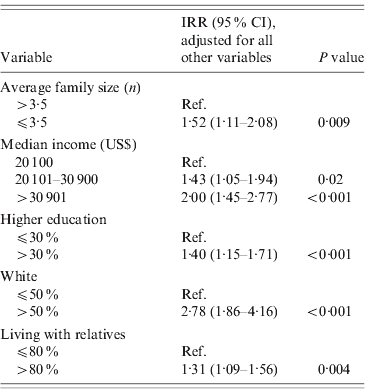To the Editor:
In the November 2011 issue of Epidemiology and Infection, Spencer et al. reported on factors associated with campylobacteriosis in New Zealand [Reference Spencer1]. We conducted a similar analysis in the state of Illinois from 2004 to 2007. During this period, the average Campylobacter rates for Illinois and the USA were 10·7 and 12·7 cases/100 000, respectively [2]. Several studies have reported an increase in cases in young adults [2–Reference Miller6], which we also observed in Illinois (9·6 cases/100 000 in the 20–29 years age group; Fig. 1). We also observed a higher rate of cases in the 50–59 years age group (14·9 cases/100 000).

Fig. 1. Average reported Campylobacter case rate in Illinois by age, 2004–2007.
To further evaluate age groups with increased rates of infection, all cases reported in the 20–29 years (n=596) and 50–59 years (n=712) age groups were geocoded to the census tract level. Demographic data for each census tract were obtained from the 2000 United States Census. In the adjusted Poisson regression models, census tracts with factors related to higher socioeconomic status (smaller family size, higher median income, higher rates of college degrees, higher percent of white population) and higher percent of population living with relatives were significantly more likely to report cases of Campylobacter in both age groups (Table 1); increased rate of home ownership, another indicator of higher socioeconomic status, was also associated with greater risk in the 20–29 years age group (Table 2).
Table 1. Census tract factors associated with reported cases of Campylobacter in the 20–29 years age group

IRR, Incidence rate ratio; CI, confidence interval.
Table 2. Census tract factors associated with reported cases of Campylobacter in the 50–59 years age group

IRR, Incidence rate ratio; CI, confidence interval.
We did not find a difference between urban and rural populations, as Spencer did; however, they found a rural/urban difference in teenagers, who were not included in this analysis. Cattle farming is uncommon in Illinois and therefore was not examined. Seasonal and sex patterns were similar to those reported by Spencer. As Spencer suggested, this association between Campylobacter and higher socioeconomic status may reflect better access to healthcare, since many cases go undiagnosed, or different eating patterns. We looked briefly at food deserts (areas where access to fresh foods are very limited so that residents rely on processed or fast foods) as a factor but found no association.
In summary, in both the 20–29 and 50–59 years age groups, several census tract factors related to higher socioeconomic status and living with relatives were associated with higher reported rates of campylobacteriosis in Illinois.
Declaration of Interest
None.







